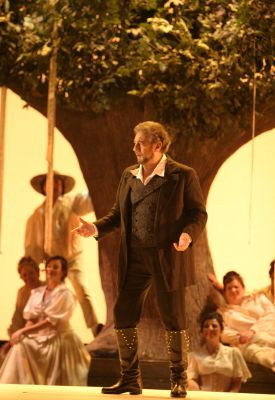|

Infectious Melodies
Torroba's zarzuela 'Luisa Fernanda'
at Los Angeles Opera,
enjoyed by MARIA NOCKIN
Spain and other Spanish speaking countries have long had their own unique theatrical forms. One of them is zarzuela, a type of operetta or singspiel in which the spoken line is at least as important as the music. The name, itself, means bramble or hodgepodge. In the 1600s, King Philip IV had early zarzuelas performed at his hunting lodge, the Palacio de la Zarzuela, which was surrounded by bramble bushes. Works from that period are known as baroque zarzuelas because they reflect musical styles of the time. Sebastian Duron's comedy, Salir el amor del mundo or 'Cupid's Final Folly' which was first performed in 1696 and recently revived in Houston, TX, is an example of that type of piece.

Placido Domingo as Vidal Hernando in LA Opera's production of Torroba's 'Luisa Fernanda'. Photo © 2007 Robert Millard
|
During the eighteenth century, most of Europe retained a fascination for Italian opera, and Spain was no exception. It took almost one hundred years for Spanish audiences to demand that a predominance of home grown musical shows be presented in their theaters. During the nineteenth century and first half of the twentieth century, performances of both the three-act romantic zarzuela grande and many light one-act comedies competed successfully with Parisian and Viennese operetta. However, in the twenty-first century, most of the zarzuelas we see are of the more serious variety. Two of the most famous zarzuela composers are: Amadeo Vives (1871-1932), who wrote Doña Francisquita in 1923 and Federico Moreno Torroba (1891-1982), best known for his 1932 opus, Luisa Fernanda.
Continue >>
Copyright © 22 July 2007
Maria Nockin, Arizona USA

|

